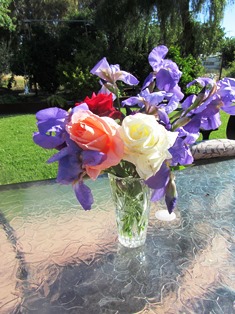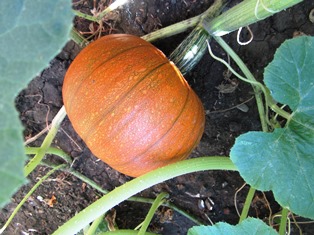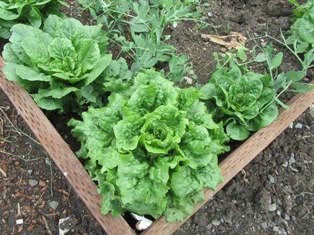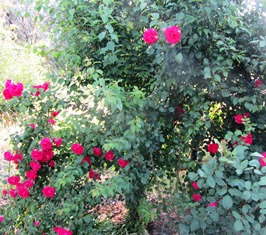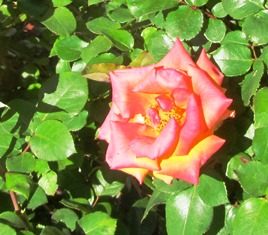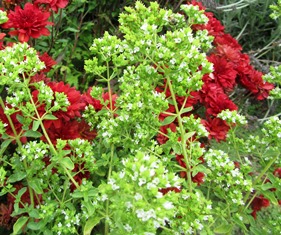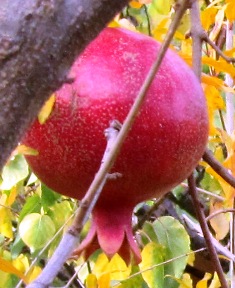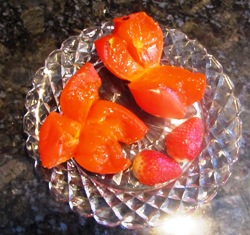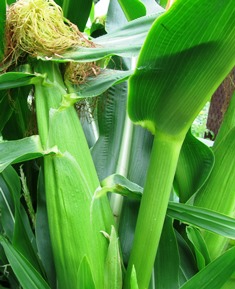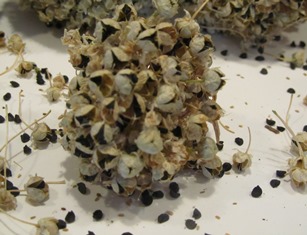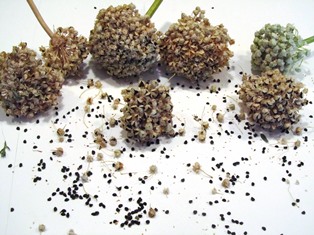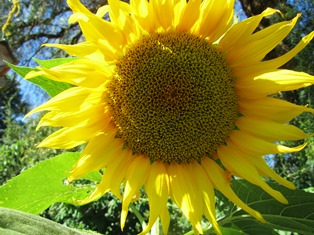Archive for the 'Gardening' Category
Remind Me Again, What Good Are Gophers?
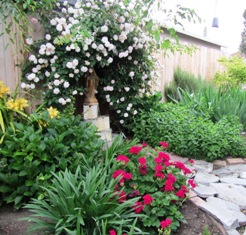
Cecile Brunner forms an arch over a statue of the Virgin Mary in one of the prettiest and most peaceful areas of my garden
The lovely Cecile Brunner rose that serves as the anchor for a small meditation garden on the northwest side of my little farmhouse suddenly appears yellowed, leafless, and lifeless. Honest to goodness, she looks like she’s croaked. It’s certainly a strange turn of events, since she had numerous new canes and the leaves were shiny and healthy only a week ago.
There is a small eruption of new dirt nearby–suggestive of moles (insect eaters) and gophers (vegetarians) and maybe voles–(voles eat roots but don’t leave mounds). So my rose problem might actually be two-fold–either way–it’s underground.
I could dig and back fill those tunnels with dirt and maybe I should. I’ve heard you can break a leg stepping into a gopher hole and I’m not talking livestock here. I wonder if the vole and gopher are sharing a network of tunnels down there dead-ending in the gopher’s bunker.
I gave the poor rose a big drink of water as soon as I discovered her condition, not knowing what else to do. As I stood there, watering with hose in hand, I saw the earth around the rose’s root cave in. Seriously?
So I’m thinking there must be a one heck of a big tunnel. This is war! I decide to stick the hose right into the tunnel and fill it with as much water as that hole will hold . . . and then some.
Strangely, while I’m dealing with the rose problem, I look past the fresh dirt mound and notice that one of the Dutch purple irises in a bed of a hundred or more has broken into full bloom. What gives? Those beauties normally bloom around Easter. I wonder why the voles haven’t attacked the rhizomes of the irises.
The condition of the Cecile Brunner climbing rose breaks my heart. Maybe she’ll spring back to life to bloom again next spring. For now, I’ll clip the beautiful iris and tuck it into a vase with some roses from other bushes on the farmette. That done, I’ll put an all-out effort into finding out how to get rid of those underground buck-tooth bandits . . . for good. Feel free to leave me your ideas. I’ve tried almost everything I’ve read on the Internet.
An Unwelcome Visitor for Brunch
I welcome visits into my yard by honey bees–they are not interested in me or my plate of food (unless it has honey on it), but hornets, wasps, and yellow jackets are not welcome.
This past Sunday morning, I was enjoying a plate of food on my patio when a yellow jacket made an unwelcome appearance. These are the yellow and black predatory wasps you find on your soda cans and sweets at picnics. Some people call them “meat bees” but they are actually wasps.
What value are they to gardens, you might wonder. I did. Although I loathe them, I did a little research and discovered that yellow jackets are predators of insects that many of us gardeners consider pests. But try as I might, I just can’t make myself like yellow jackets. The females don’t just sting and die. They can sting multiple times. And wasp stings hurt.
About those stingers–they are like lances with barbs, injecting venom into you during a sting. The stings are not dangerous unless you happen to be stung repeatedly or you are allergic to bee and wasp stings. In that case, you might carry a epinephrine autoinjector (known as an EpiPen) in the event of a life-threatening sting to treat anaphylaxis.
Keep a lookout for yellow jackets in the spring when the queen seeks a place to construct a paper nest. These wasps (related to hornets) live in social colonies with female queens and workers, and also males, known as drones. They like to establish their nests in hollowed logs and human structures (like houses with holes for entry into attics or walls). They enjoy a diet rich in sugar and carbohydrates. Don’t we all? But take care when enjoying your al fresco Sunday brunch. You never know who might drop in!
Cool Season Plantings for Soup, Salad, and Pie
This time of year the French sugar pumpkins, persimmons and pomegranates are ready to harvest and that means it’s also time to plant cool season crops.

My summer onions formed large bulbs that I have already harvested; it’s time to replace them with bunching onions
Yesterday I turned the dirt in one of my large planting boxes, added in some aged manure and other soil amendments, and planted red and yellow onions for soups and salads during the fall and winter. I harvested seed from my summer onions and during the winter months will grow the seed in flats for spring planting.
The cool days ahead are perfect soup days and that means carrots, fennel, cilantro, cauliflower, potatoes, and bok choy will also find a place in my fall and winter garden.
In other raised beds and boxes, I’m planting heirloom lettuces, radishes, and spinach. These traditional salad ingredients are best grown during the fall or early spring as hot weather tends to make them bolt.
The pumpkins are ready for pie-making and Halloween carving. The persimmons are perfect for custards or for eating fresh when absolutely ripe (otherwise, the fruits are so tart they will make you pucker). And those lovely red pomegranate seeds are delicious eaten raw or tossed into salads.
For a list of Northern California cool seasons vegetables, check out Sunset Magazine’s edible gardening guide at http://www.sunset.com/garden/garden-basics/cool-season-crops-00400000042441/. If you plant to purchase seed f0r your own cool season garden, I urge you to choose non-genetically modified and open-pollinated seeds so that you can harvest.
The Narrative of the Rose in My Life
If you could be any flower, which one would you be? My choice would be a rose–not only for its exquisite beauty, intense color, and sweet scent but for its incredible ability to regenerate and for its symbolism in love, war, beauty, and politics–universal experiences that individually or collectively affects our lives . . . or, for the purpose of this musing, my life.
It might have been the Chinese who first cultivated the rose, nearly 5,000 years ago, but there is fossil evidence that the wild rose is far older–at least 35 million years old. Now that’s what I call “staying power.” The rose is a beautiful species, some might say delicate, but I wouldn’t be one of them. The rose regenerates, endures, and thrives. I want to be like that–always–if not in body, at least in spirit.
My fondness for roses surely began when I was a small child living on a farm where roses formed wild hedges or spilled over covered bridges on lovely and lonely dirt roads in rural Missouri that led to farms and country cemeteries and fishing holes.
Every year in May, my Scots-Irish grandmother and mother would cut branches of roses to put into glass canning jars of water, festooned in ribbon or pieces of quilting gingham. With me in hand, they would carry the rose bouquets to graves throughout the county where their loved ones were buried. I watched, not entirely understanding why everyone wasn’t buried in the same patch of ground and whether or not the spirits of the dead would enjoy the roses.
My junior prom was all about yellow roses. The pattern covered the gown my mother and her new husband could scarcely afford and filled the corsage my date brought . . . along with a promise that he would be return and take me to the dance. He didn’t. As it turns out, he took someone else, apparently believing I would be satisfied with roses.
Although I still associate the yellow rose with that disappointment, I am grateful that my love for them has endured (real love always does) while my infatuation with that jerk quickly ended.
While I studied the War of the Roses in my world history book, linkage between the rose and politics came about for me at a garden party years ago for California’s lieutenant governor at the home of a wealthy patron in Hillsborough. As I recall, I was more interested in the variety of roses growing on that vast estate than what was being said in threads of conversations going on around me.
Pink roses on the front porch next to my bedroom were bursting into bloom the spring my brother left for Vietnam, dressed proudly in his marine uniform. The sweet spice-laden scent of their blossoms wafted into my room each night as I said prayers for his safe return.
Years later after being wounded and shipped home, he and his wife attended my wedding. The dinner table was lavishly adorned with red roses, green fern leaves, and white baby’s breath in vases next to fine china and crystal stem flutes of celebratory champagne. My dress of cream-colored satin and my husband’s ivory-colored silk vest under his dark suit created the perfect foil for the red roses, proclaiming our romantic, passionate, undying love for each other.
Hours before my husband died, I massaged his weary legs with rose-geranium oil and prayed for strength. His passing came three weeks after Valentine’s Day. I sprinkled rose petals everywhere in the house in remembrance of his life that had, like the tall, strong canes of a climber, had so intimately intertwined with mine.
I chose Honor, a near-perfect white rose, to plant in remembrance of him, knowing that its pristine blooms and abundant leaves were sustained by roots hidden away in the bosom of the earth. The re-emergence of that rose always reminds me that one’s spirit is nourished by that which is seen and unseen and that the soul is eternal.
After starting life anew on the Henny Penny Farmette, I planted two entire rose gardens and tucked in other rose bushes, including some fifty-year-old wild roses, dug from a friend’s ancestral home.

Strong canes with eye buds can be dipped in rooting hormone and put into the ground to grow a new bush
In one area of the farmette, I’ve planted a single row of white roses commemorating the military service of my great grandfather (who fought the decisive Battle of Pea Ridge in the Civil War), my grandfather (whose wounds in Great War in Europe resulted in his death), my father-in-law who served in the Merchant Marines and World War II (where his ship the Exodus, a.k.a. President Warfield, ran the British blockade of Palestine to rescue 4,500 Jewish refugees), and my son’s father, who would have served our nation had it not been for the heart condition that resulted in his early death.
Some roses I’ve planted, especially those that I’ve started from canes clipped or grafted from other people’s plants, remind me of new life and new beginnings. Somehow, these clippings survive and grow into healthy bushes of roses in many different colors. These roses give me immense pleasure, whether in the garden or in vases in my cottage.
Love and death, wars, and politics will continue in their seemingly endless cycles. Long after I’m gone, members of my family, their children, and grandchildren may forget why certain bushes were planted and in whose names. But perhaps they will remember me as a woman for whom roses symbolized important events in the narrative thread of her life and the plants themselves nourished her spirit.
Plant Culinary Herbs for Yourself and the Honeybees
During my pre-rainstorm walk today around the farmette, I noticed honeybees foraging for nectar in the last blooms of the cosmos, nasturtiums, and rose geraniums.
This is the time of year that the bees search for autumn pollen and find it in the last flowers of a summer garden, but also in the blooms of lavender, heather, thistle, balsam, and eucalyptus.
In the spring, I planted a large pots of culinary herbs on my patio to use in cooking. The mixture of plants included sage, parsley, marjoram, chives, sweet basil, rosemary, English thyme, Greek oregano, Lebanese mint, chocolate mint, lemon bee balm, spearmint, and French tarragon.
If you enjoy using such herbs in autumn and winter soups, teas, or breads, for example, consider planting pots of herbs to grow on the patio or on a shelf in a garden window or on the window sill. The plants will brighten the cooking area on dreary dark days and, with just a snip, add flavor to your culinary creations.
Grow mint in pots if you don’t want it spreading over your yard. The same is true for the Greek oregano and also English thyme and French tarragon–those plants will grow beautifully even though confined in clay pots, old urns, or even half wine barrels.
In early autumn, there is a diminishing amount of nectar (in blooms) available for the bees. This is the known as the nectar gap–when the sources of nectar for the bees are minimal and new sources have not yet appeared. This time of the year to think about planting for yourself and also the honeybees.
Pomegranates and Persimmons Are Ripening Now
The pomegranates are turning from green to a deep red as they should be. It’s the middle of September after all. Some have split open, exposing the red seeds inside the fruits. My neighbor says it’s because of uneven watering. These trees don’t need much water and, I admit, I’ve been lax about running the hose on them.
The seeds are luscious, bursting with sweet-tart flavors. Eat the seeds raw or toss them into a citrus salad with fresh greens, oranges, sweet grapefruit sections, kiwi slices, tangerine sections, crunchy apple and pear slices, and sugared pecans.
While I wait for tomatoes (yes, an old heirloom variety of tomatoes with lots of vines that ripen late season) and the French pumpkins to ripen, I’ve noticed that the persimmons have turned a bright orange, but are still quite firm to the touch.
I planted hachyia persimmons instead of fuyu simply because I like them better. The fuyu persimmons are like small, flat apples. They are crunchy and perfect in salads. The hachyia variety can be eaten fresh or incorporated into baked goods.
If not completely ripened, the hachiya are tart–mouth-puckeringly so. But when they are ripened to perfection, they become soft and sensual like custard. To me, there’s nothing quite like those fruits.
Hasten the ripening of both fuyu and hachyia persimmons in the kitchen in a paper bag. Always look for bright glossy color and a heavy weight to the fruit when selecting fruit to eat or bake.
The hachyia variety adds a pumpkinlike flavor to bake goods as well as additional moisture. The hachyia has earned the moniker of “the baking persimmon.” Try using them in cakes, puddings, breads, and cookies.
Think of pomegranates and persimmons as early autumns special treats. The pumpkins and apples will follow. Then for us Northern California gardeners, the work starts in earnest for preparing beds for our cool season gardens.
Summer Garden in Review
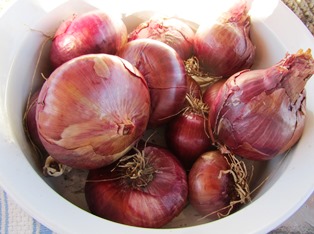
Red onions, grown from sets laid onto prepared beds of soil and barely covered with dirt, produced bulbs all summer
As I prepare and amend planting beds to sow some cool season crops, I am also reviewing my summer garden. I will be the first to admit it was less than a stellar year for my vegetables, except for the peppers, eggplants, summer squash, cherry tomatoes and the sweet French pumpkins for pie, Rouge Vif d’Etampes.
We bought seedlings of heirloom tomatoes and also grew some plants from seed (captured and preserved from last year). The paste tomatoes produced abundantly, but I didn’t get many slicing tomatoes and the cantaloupe and Armenian cucumber plants performed dismally for me. Last summer, those two were star performers in my garden.
The German heirloom Riesentraube (the name means “giant bunch of grapes”) will produce sweet, red 1-ounce fruits, if they ever ripen. The plant’s vines have spread like a wild weed all over the garden and are covered in blooms. The plant is a heavy producer but the fruit is still green. To be fair, I planted this one later than the other heirloom tomatoes, so it may yet surprise me.
Of the blue-black tomatoes we planted, the most notable are Blue Beauty and Indigo Apple. I loved the taste and the thin skin of Blue Beauty but Indigo Apple’s small fruit, despite being described as sunburn and crack resistant, suffered from both in my summer garden.
My patch of sweet summer corn produced lots of ears but quickly became infested with corn aphids that I had difficulty controlling. Finally, I ripped out the whole patch.
We had an abundance of raspberries and strawberries this year. Although we picked strawberries every morning from early May throughout the summer, those strawberries kept on blooming and producing. The blackberries produced lots of vines, but few berries. My blueberry bush went into the compost pile–the soil is too clay and alkaline. I’ll try growing one next year in a wine barrel with acid soil, maybe adding some pine needles, sulfur powder, peat moss, and sawdust mulch.
Our White Genoa fig tree is loaded with ripening figs and the Fuji apple, a few feet away, has branches needing support for the low-hanging, heavy apples. We picked and ate all the sweet summer-ripening Bartlett pears. Now, while we await the fall pears ripening, we’ll keep an eye on the blood oranges from which I hope to make marmalade in late winter when the fruit on the citrus trees ripens.
So, in review, this summer’s garden wasn’t the best. But gardeners, myself included, are eternal optimists, ever dreaming of the next plant, the next season. As English writer and gardener Vita Sackville-West astutely observed, “The most noteworthy thing about gardeners is that they are always optimistic . . . always look forward to doing something better than they have ever done before.”
Attracting Butterflies into Your Garden

The Western Tiger Swallowtail, shown here on geraniums, resembles its counterpart, the Eastern Tiger Swallowtail
While sipping my morning coffee today, I spotted a Western Tiger Swallowtail butterfly in my garden. So naturally, I had to put down my mug of coffee and grab my camera.
These beauties have wingspans stretching up to four inches. The butterflies are often seen in woodlands around streams and riverbanks or canyons in the west. For a complete list of butterflies for Northern California, see http://www.thebutterflysite.com/california-butterflies.shtml
Here on the farmette, these beautiful butterflies feed on the nectar of the garden plants. I often see them on the blooms of my hedge of lavender and elsewhere on the zinnias. They also flit over and and perched on the water fountain near where I grow roses and wisteria.
You can attract these particular butterflies into your Northern California gardens by planting petunia, Mexican sunflower, dianthus, and the butterfly bush. But do a little research on creating a butterfly garden if you want to attract different types of butterflies. And don’t use pesticides or insecticides if you are serious about creating such a haven.
Growing Onions from Seed
This afternoon, I harvested a basketful of onions (mostly red ones as I planted more of those in April than the yellow ones I use for soup). Red onions taste great in salads or sauteed with garlic and cooked into a sofrito that is added to beans.
I planted the onions in April in planter boxes that my husband built last year (four feet by six feet). This year, I put out sets. But since I’ve harvested seed this summer from the onions I grew from those sets, I will grow next year’s crop from the seed, starting them in seed flats in the kitchen in February.
Here’s how to grow onions from seed.
1. Sow the onion seeds about 1 inch deep in seed flats with seed starting mix.
2. Keep the soil moist and warm until the seeds germinate (about a 10 days to 2 weeks).
3. Keep the young onion shoots moist and warm as they grow.
4. In April or May after the ground outside has warmed sufficiently, replant the seedlings two to a hole about 4 to 6 inches apart in fertile, well-drained soil. (I lay my onion sets on the soil and cover lightly. They are shallow rooted. Do not plant too deep.
5. Water and remove weeds regularly.
6. Harvest onions in midsummer. Let dry in a dark, cool place.
Giant Sunflowers Are Fun for Kids and Easy to Grow
Today, I harvested the largest sunflower in my garden. The 119-inch stem (almost 10 feet) had bent over from the weight of the 15-inch seed head.
The seeds of this annual were already drying and starting to drop from the head. Since I want to harvest and store them, I don’t want to risk new plants emerging from where the seeds have drop onto soil. And I don’t want the squirrels to get the seeds before I’ve saved some.
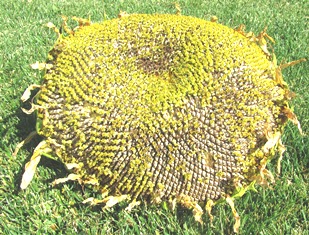
Giant sunflower head, newly harvested, covered with florets that will dry and fall off or can be brushed off to expose seeds
The sunflower I grew emerged from a single stalk that bore only one head with sunny yellow-petaled face. I planted it from seed I saved last year from the parent. If you want a row of giant plants, you’ll need to space them about 20 inches apart.
Kids love these giants when they are trained to grow in fairy rings, fortlike squares, or as tee-pees. The plants are much appreciated by the honeybees, squirrels, and songbirds. Best of all, the stalks can go into the compost pile when the growing season is over.
Our farmette soil is clay. In the area where I planted these sunflowers, I amended the soil with chicken manure and peat. The seedd went in about 1 inch deep and five to six inches apart. Last year, we grew the sunflowers in a circle, but this year we have a row at the back of the property in front of a fence.
Once the seeds are planted, a thorough watering will help them germinate within about a week. Keep them moist until they germinate, then water on a regular basis. I feed them once during the growing cycle with a cup of fish emulsion diluted in a five-gallon bucket of water. Otherwise they aren’t too fussy about soil and can even withstand some drought conditions.
Find heirloom organic seed that is non-GMO at any of the following seed companies:
Baker Creek Heirloom Seeds at http://www.rareseeds.com/mammoth-grey-sunflower/
Victory Seeds at http://www.victoryseeds.com/helianthus_annuus_giant.html
High Mowing Organic Seed at http://www.highmowingseeds.com/organic-seeds-mammoth-sunflower.html
Bountiful Gardens at http://www.bountifulgardens.org/products.asp?dept=70
All Good Things Organic or AGTO Seeds at http://www.agtoseeds.com/products/organic-russian-mammoth-sunflower-seed
 Facebook
Facebook Goodreads
Goodreads LinkedIn
LinkedIn Meera Lester
Meera Lester Twitter
Twitter





